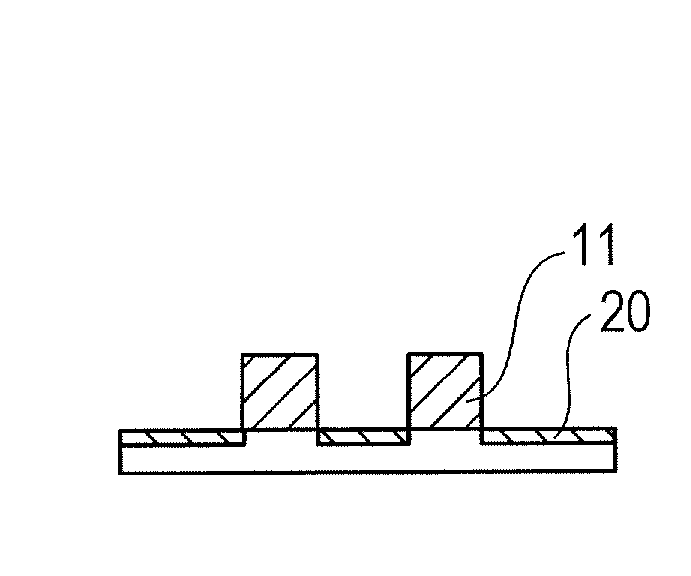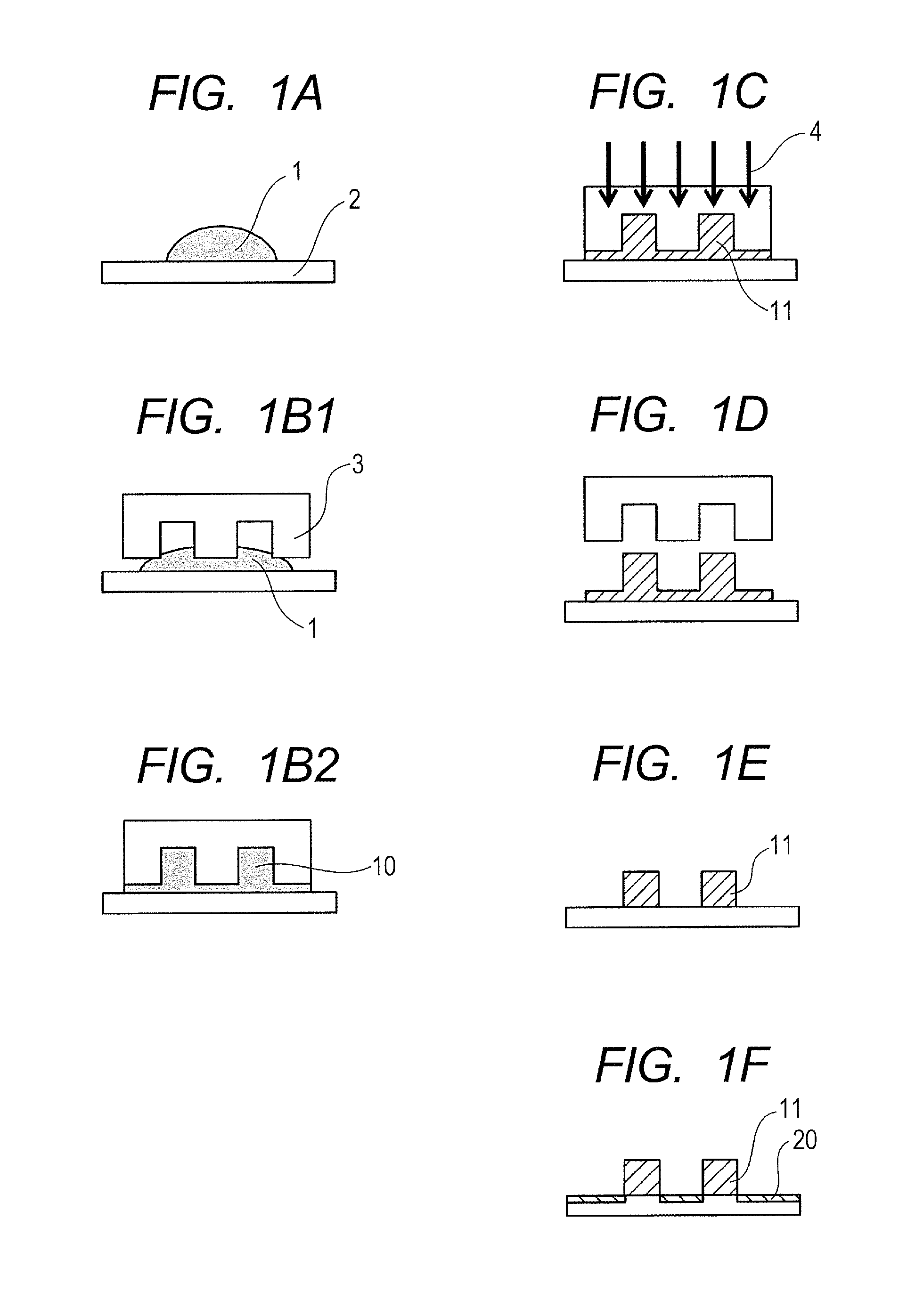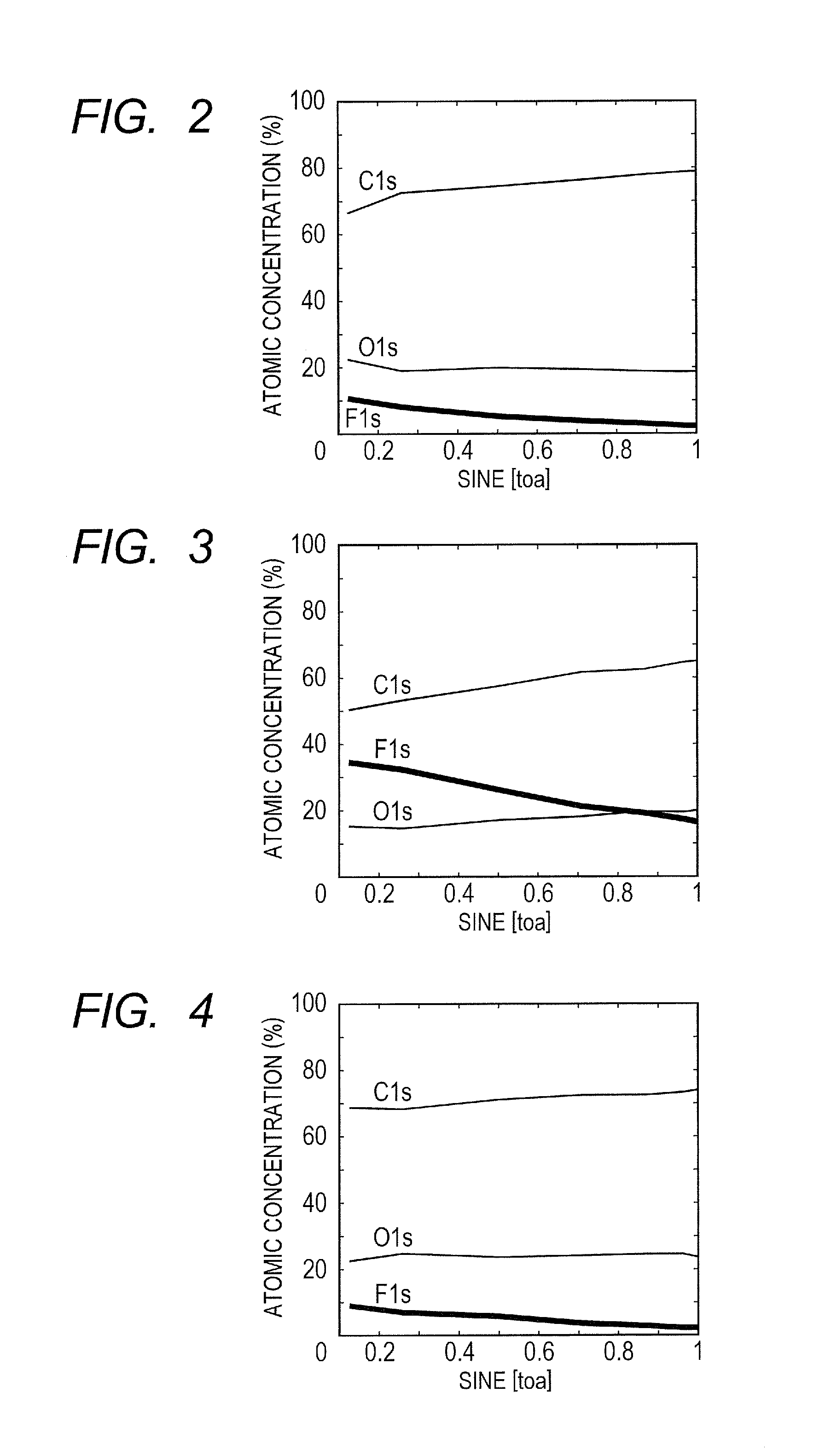Photocured product
a technology of photolithography and product, applied in the field of photolithography products, can solve the problems that the photolithographic technique has also come close to the limit, and achieve the effect of reducing the release force of the mold
- Summary
- Abstract
- Description
- Claims
- Application Information
AI Technical Summary
Benefits of technology
Problems solved by technology
Method used
Image
Examples
synthesis example 1
Synthesis of Surface Active Agent (C-1)
[0140]A 300 mL reactor whose inside system had been set to a nitrogen atmosphere was charged with the following reagents and solvent:
Hexaethylene glycol (PEG6): 26.5 g (93.9 mmol, 1.0 eq)
Carbon tetrachloride (CCl4): 36.1 g (235 mmol, 2.5 eq.)
Tetrahydrofuran (THF): 106 mL
[0141]Next, the reaction solution was cooled to −30° C. Then, a THF solution prepared by mixing 24 mL of THF and 15.3 g (93.9 mmol, 1.0 eq) of dimethyl amino phosphine was slowly added to the reaction solution over 2 hours, and the resulting solution was stirred for 30 minutes at that temperature (−30° C.). After removing the cooling bath, the reaction solution was stirred at room temperature for 2 hours. Then, 250 mL of city water was added to the thus obtained pale yellow suspension, so as to divide the resultant into two layers (of a CCl4 layer and an aqueous layer). The aqueous layer was washed twice with 150 mL of isopropyl ether (IPE). To the resulting aqueous layer, a sus...
synthesis example 2
Synthesis of Surface Active Agent (C-2)
[0144]A 100 mL reactor whose inside system had been set to a nitrogen atmosphere was charged with the following reagents and solvent:
Hexapropylene glycol (P400): 20 g (50 mmol, 1.0 eq)
Carbon tetrachloride (CCl4): 19.2 g (125 mmol, 2.5 eq.)
Tetrahydrofuran (THF): 100 mL
[0145]Next, the reaction solution was cooled to −30° C. Then, a THF solution obtained by mixing 30 mL of THF and 8.16 g (10 mmol, 1.0 eq) of dimethyl amino phosphine was slowly added to the reaction solution over 2 hours, and the resulting solution was stirred for 30 minutes at that temperature (−30° C.). After removing the cooling bath, the reaction solution was stirred at room temperature for 2 hours. Then, city water (350 mL) was added to the thus obtained pale yellow suspension, so as to divide the resultant into two layers (of a CCl4 layer and an aqueous layer) by a separating operation. The obtained aqueous layer was washed twice with 150 mL of isopropyl ether (IPE). To the r...
example 1
(1) Photocurable Composition
[0148]The following reagents were blended:
1,6-Hexanediol diacrylate (manufactured by Osaka Organic Chemical Industry Ltd.): 100 parts by weight
Irgacure 369 (manufactured by Ciba Japan K.K.): 3 parts by weight
Surface active agent (C-1): 2 parts by weight
[0149]Next, a mixed solution obtained by blending the above-described reagents was filtered by a 0.2 μm tetrafluoroethylene filter, so as to prepare a photocurable composition (a-1).
[0150]The surface tension of the photocurable composition (a-1) measured by using an automatic surface tension balance CBVP-A3 (manufactured by Kyowa Interface Science Co., Ltd.) was 21 mN / m. Furthermore, the viscosity of the photocurable composition (a-1) measured by using a cone-plate rotational viscometer RE-85L (manufactured by Toki Sangyo Co., Ltd.) was 6.48 cP.
[0151]Next, a photocured product was prepared by the following method.
(2) Applying Step
[0152]Onto a 4-inch silicon wafer having an adhesion accelerating layer wit...
PUM
| Property | Measurement | Unit |
|---|---|---|
| size | aaaaa | aaaaa |
| size | aaaaa | aaaaa |
| surface active | aaaaa | aaaaa |
Abstract
Description
Claims
Application Information
 Login to View More
Login to View More - R&D
- Intellectual Property
- Life Sciences
- Materials
- Tech Scout
- Unparalleled Data Quality
- Higher Quality Content
- 60% Fewer Hallucinations
Browse by: Latest US Patents, China's latest patents, Technical Efficacy Thesaurus, Application Domain, Technology Topic, Popular Technical Reports.
© 2025 PatSnap. All rights reserved.Legal|Privacy policy|Modern Slavery Act Transparency Statement|Sitemap|About US| Contact US: help@patsnap.com



